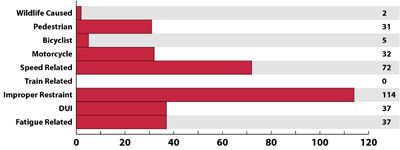Along with drowsy and impaired driving, the national zero fatalities program has outlined several other conditions that can seriously affect an individual’s ability to drive safely.
With the busy Memorial Day weekend around the corner, state and local officials remind Carbon County motorists to obey all traffic laws and take extra precaution.
According to zerofatalities.com, the best way to survive a crash is to prevent the traffic accident from happening in the first place.
“Before you get behind the wheel, ask yourself a few questions,” advises the website.
The site points out that local drivers should evaluate several factors.
The factors include “how tired you are, how distracted certain electronic devices could make you, has a situation made you too angry or upset, have you taken any substances that may impair your driving and do you plan to buckle up and make sure all passengers buckle up as well?” states the website.
During the past five years, there has been a steady decline of traffic fatalities on Utah’s roads.
The declining trend can be attributed to four different areas, according to the zero fatalities program.
The factors include:
•Planning efforts by a coordinated group of state agencies.
•Continual efforts in engineering improvements in roads and vehicles.
•Educational programs for new and existing drivers.
•Enforcement initiatives to help ensure proper driving behavior.
“However, these combined efforts will only get us so far in saving lives,” indicates the website. “Every person behind the wheel has a responsibility to themselves and to other motorists to drive safely.”
Safety belts are approximately 50 percent effective in preventing fatalities in crashes in which motorists would otherwise die. Therefore, according to the site, raising safety belt usage saves lives.
In 2005, 282 motor vehicle occupants died on Utah roadways. Of the fatalities, 208 of the victims were unrestrained or improperly restrained.
Based on historical national studies, traffic safety officials estimate that 50 percent or 104 of the victims would have survived if they had buckled up.
Utah’s 2005 safety belt observational survey shows that 86.9 percent of motorists buckled up.
The number may seem acceptable to many people, according to the zero fatalities website, but 13.1 percent of Utah’s population or about 313,000 people still don’t buckle up.
Carbon County motorists are cautioned to remember that law enforcement officers will issue citations to unbuckled drivers and passengers.
Utah law states that drivers and passengers must wear a properly adjusted and fastened safety restraint.
The law provides for primary enforcement for individuals up to 19 years of age.
In addition children four years and under must ride in an approved child safety seat.
For a person 19 or older, enforcement by an officer can be only as a secondary action when the person has been detained for another offense.
The offenses could be speeding, aggressive driving, transporting an unrestrained passenger who is younger than 19, among other traffic violations.
A secondary law does not mean that drivers and passengers can legally ride unbuckled.
Tips for properly and regularly wearing a seat belt include:
•Always fastening lap and shoulder belts. Shoulder belts should fit across the collar bone and the lap belt should fit low over the hips.
•Never place the shoulder strap under your arm or behind your back.
•The safest place for any child ages 12 and younger is the back seat.
•Infants should ride rear-facing as long as possible and at least until they are 20 pounds and one year of age.
•Children should be securely fastened in a forward-facing child safety seat once they have outgrown their rear-facing seat and until they are about 40 pounds.
•Use belt-positioning booster seats to help position adult-size seatbelts for children who have outgrown their toddler safety seat.
•More than 80 percent of child safety seats are used incorrectly. Be sure to read the car seat and vehicle owner’s manual and follow all instructions to be sure your child passengers are safe.
Along with not wearing a seatbelt, aggressive drivers can also be a danger to Utah motorists. According to zero fatalities, aggressive driving means operating a vehicle in a way that endangers or is likely to endanger people or property. Most behaviors associated with aggressive driving are illegal.
•Speeding.
•Running red lights.
•Failure to yield.
•Tailgating
•Weaving.
To respond to an aggressive driver the site recommends wearing a seatbelt and not playing their game.
“Back off and let them go on their way,” states the site. “Remember, it’s not a competition and it’s not your job to teach them a lesson.”
Zero fatalities program identifies conditions jeopardizing traffic safety

